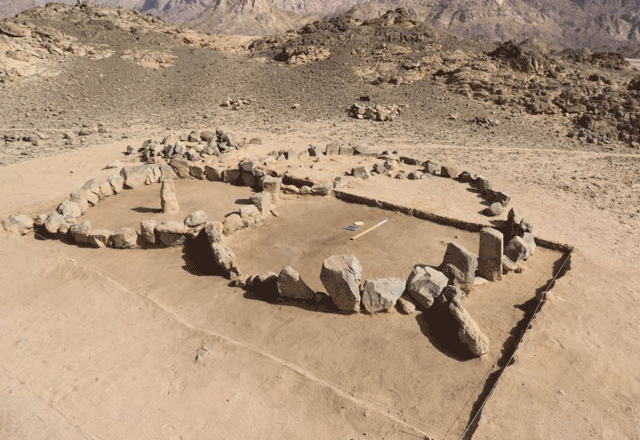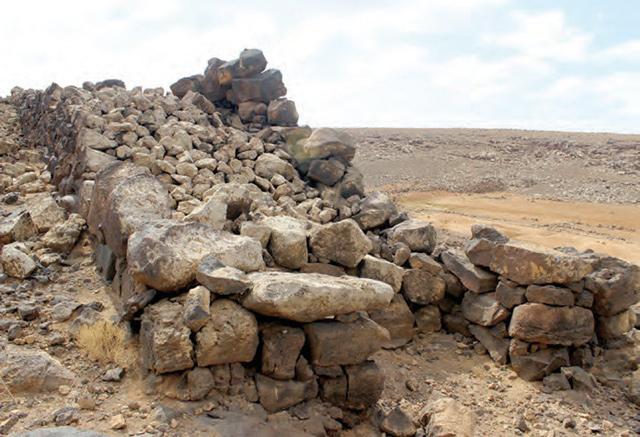You are here
Feline images discovery ‘adds new page to history of art and archaeology in Jordan’
By Saeb Rawashdeh - Jul 15,2018 - Last updated at Jul 17,2018

‘Awja1 is a site below the southern escarpment of Al Jafr Basin, some 300km south of Amman (Photo courtesy of Sumio Fujii)
AMMAN — In the middle of a sand desert in southern Jordan, a group of archaeologists has found unique feline representations.
A site is located below the southern escarpment of Al Jafr Basin, some 300km south of Amman. “‘Awja1 is a small site that was pinpointed in 2010 with the clue of ambiguous information from local residents,” said Japanese scholar Sumio Fujii from Kanazawa University.
The research team decided to embark on a full-scale excavation of the remote site due to the slight exposal on the ground surface of an elongated structural complex (reminiscent of the Late Neolithic settlement-shaped open-air sanctuariespreviously excavated by them at Qa’ Abu Tulayha and Harrat Juhayra), Fujii recalled.
The first excavation season took place in the summer of 2011, revealing the overall picture of the complex which consists of four rectangular units, he said, adding that the site was entirely empty and devoid of any artifacts. “This makes sense to us, and scholars consider that it was an open sanctuary irrelevant to practical life,” he stated.
“In addition, we found a stone alignment circa 30-cm-long protruding from the southeastern corner of the operation area, but we took it lightly as a part of another unit,” the archaeologist explained, noting that, on the first day of the next field season, the guess turned out to be an utter failure.
“Scholars were surprised when they noticed the tip of the tale of a feline feature and they immediately enlarged the operation area southeastward where they confirmed seven similar features,” he recounted, adding “there is no doubt that the quadrupeds represent feline animals, probably cheetahs or panthers. This is because they have a slender trunk, a relatively small and rounded head without horns, and, among others, a long tail curling only its tip upward.”
Similar iconographies can be found in petroglyphs from other Neolithic sites in the Jafr Basin, suggesting that the feline animal was thought to have some magical power, according to Fujii, who noted that the feline group consisted of four adults and four juveniles.
He continued: “The former were relatively well preserved and circa two to three metres long, while the latter were less preserved and circa one to one-and-a-half metres long.”
As for the adjacent “pseudo-settlement”, they were constructed with upright sandstone slabs up to around 50 cm long arranged in two parallel rows, he said, stressing that neither diagnostic artifacts nor charcoal remains for C-14 dating were recovered. However, the existence of similar features at a few Late Neolithic sites in the Negev Highlands and the Sinai Peninsula suggests a date of circa 5,000 BC for the Awja felines, Fujii explained.
Regarding religious practices related to feline images, they were probably used together with the structural complex, for some open-air ritual of the early pastoral nomads who migrated to south Jordan, but its details still remain unknown, Fujii explained.
“Though still not very well known except for a limited number of specialists, this unexpected finding added a new page to the history of art and archaeology in Jordan. We had no choice but to backfill the features, but, needless to say, their relocation and reconstruction at an appropriate place such as the forecourt of the Jordan Museum would be more desirable,” the expert concluded.
Related Articles
AMMAN — New excavations in Wadi Abu Tulayha help understand the Late Neolithic cultural landscape in southern Jordan, noted a Japanese profe
AMMAN — Scholars predominantly began exploring Jordan’s prehistory in the mid-1970s, according to a Jordanian archaeologist.“The archaeologi
AMMAN — Ain Ghazal (Spring of the Gazelles), near Marka in the capital, was “the Manhattan of the Neolithic period”, according to an anthrop













